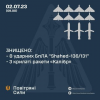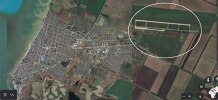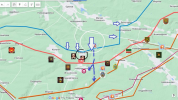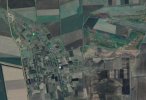Antares
Respected Leader
Näkemys että Primorsk-Akhtarsk sotilaslentokentän seudulle tehdyn iskun uutisoinnissa nähty kuva (alla) on todennäköisemmin Kh-22 ohjuksen osuma. Kraatteri on liian suuri ja syvä ollakseen esim. Storm Shadow.
About the photo of the funnel near the airfield in Primorsk-Akhtarsk in the Krasnodar Territory. Obviously, this is not Storm Shadow, SCALP, or some other means of destruction. The funnel is too large for this and looks more like the result of the impact of the Kh-22 rocket.
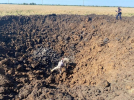
Through the Primorsk-Akhtarsk sector, from time to time, flights of Tu-22M3 strategists and launches of Kh-22 missiles are carried out. In turn, it is well known that the Kh-22 is not only a very inaccurate missile, but also defective, especially in matters of reliability of its fuel system.
In 2022, 3 Kh-22s fell into the Black Sea due to a fuel system failure. In this regard, one should ask the question whether there were Kh-22 carriers in the air at the time of the incident in the Krasnodar Territory. If yes, then we can congratulate Primorsk-Akhtarsk on successfully taking over from Belgorod.
-
En muista kuulleeni Kh-22 laukaisuista viime päivinä, tosin muistamme että Tu-22M3 pommikoneiden sanottiin lentäneen Kaukasukselle Mozdok sotilaslentokentälle:
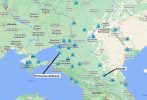
Venäjä on laukaissut risteilyohjuksia tyypillisesti joko Kaspianmeren pohjoisosista tai Mustanmeren yltä, joten Primorsko-Akhtarsk ei ole ihan suoraan lentoreitillä - toki riippuen mikä on kohde ja onko kyseessä harhautunut ohjus.
On myös mahdollista että tuota kuvaa on käytetty ns. kuvituskuvana.
Uskon kuitenkin että kentän seudulle on tosiaan isketty ja iskun seurauksena jotain palaa / palanut, koska iskun jälkeen on nähty kuvia kentän suunnalta nousevasta savupilvestä.
About the photo of the funnel near the airfield in Primorsk-Akhtarsk in the Krasnodar Territory. Obviously, this is not Storm Shadow, SCALP, or some other means of destruction. The funnel is too large for this and looks more like the result of the impact of the Kh-22 rocket.

Through the Primorsk-Akhtarsk sector, from time to time, flights of Tu-22M3 strategists and launches of Kh-22 missiles are carried out. In turn, it is well known that the Kh-22 is not only a very inaccurate missile, but also defective, especially in matters of reliability of its fuel system.
In 2022, 3 Kh-22s fell into the Black Sea due to a fuel system failure. In this regard, one should ask the question whether there were Kh-22 carriers in the air at the time of the incident in the Krasnodar Territory. If yes, then we can congratulate Primorsk-Akhtarsk on successfully taking over from Belgorod.
-
En muista kuulleeni Kh-22 laukaisuista viime päivinä, tosin muistamme että Tu-22M3 pommikoneiden sanottiin lentäneen Kaukasukselle Mozdok sotilaslentokentälle:

Venäjä on laukaissut risteilyohjuksia tyypillisesti joko Kaspianmeren pohjoisosista tai Mustanmeren yltä, joten Primorsko-Akhtarsk ei ole ihan suoraan lentoreitillä - toki riippuen mikä on kohde ja onko kyseessä harhautunut ohjus.
On myös mahdollista että tuota kuvaa on käytetty ns. kuvituskuvana.
Uskon kuitenkin että kentän seudulle on tosiaan isketty ja iskun seurauksena jotain palaa / palanut, koska iskun jälkeen on nähty kuvia kentän suunnalta nousevasta savupilvestä.


